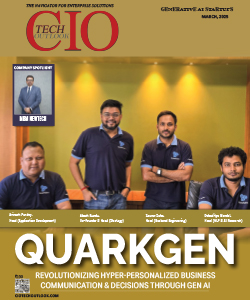Beyond Traditional Security: A Guide to Next-Gen WAFs
Shibu Paul, Vice President, International Sales, Array Networks

Shibu Paul has 25 years of experience in the field of Digital transformation – IT, IS and telecom – having worked with Sify Ltd, British Telecom Global services (India) and BT Americas in various roles.
The digital revolution has transformed how businesses operate. Web applications are at the forefront of this change, powering everything from online stores to customer portals. However, this increased reliance on web applications creates a critical vulnerability – cyberattacks.
These attacks are more than just a nuisance. Malicious threat actors steal sensitive data, disrupt operations, and damage organizational reputation.
The rate at which these attacks are evolving makes traditional security measures ineffective. Therefore, with next-gen web application firewalls, organizations can mitigate evolving vulnerabilities and keep their business and customer data safe.
What is a next-gen web application firewall?
Next-gen WAFs go beyond signature-based detection, which relies on predefined attack patterns. They leverage machine learning to identify and block new and evolving threats, including zero-day attacks that have yet to be documented.
Operating at multiple application layers, the next-gen WAF protects against threats like DDoS attacks, data scraping, and API vulnerabilities.
Next-gen WAFs include additional functionalities like SSL offloading (handling encrypted traffic), multi-layer protection (combining the application layer with other security measures), and data leak prevention.
What are the benefits of a Next-Gen Web Application Firewall (NGWAF)?
Each next-gen WAF offers distinct benefits. For instance, the Array ASF series offers the following benefits:
1. Multi-layer defense
Beyond signature-based detection, Next-Gen WAFs provide a multi-layered security defense. This comprehensive approach safeguards against threats at all levels, from Layer 3 to Layer Next-gen WAFs offer advanced features like DDoS mitigation, access control with whitelists and blacklists, protocol compliance checks, and protection against techniques like cookie tampering, brute force attacks, data leeching, and malicious crawling/scanning.
Additionally, Data Leak Protection (DLP) rules prevent the unauthorized exposure of sensitive user information such as identity details, phone numbers, email addresses, and credit card numbers. This multi-layered approach ensures your web applications are shielded from a wide range of threats, fortifying your security posture.
2. SSL Offloading
By handling encryption and decryption tasks (hardware or software-based), the Next-gen WAF frees up web servers, boosting their performance. This offloading also allows for deeper inspection of encrypted traffic (HTTP packets), effectively eliminating hiding places for attacks that leverage encryption methods. This multi-layered approach ensures threats have nowhere to evade detection, further solidifying web application's security posture.
3. Server protection
Next-gen WAFs offer granular control over web traffic, allowing deep security checks. This translates to benefits like enhanced protocol compliance, advanced defense mechanisms, and broad spectrum coverage.
By filtering HTTP packets based on specific characteristics, next-gen WAFs ensure your web applications adhere to security protocols and prevent unauthorized access attempts. Additionally, features like header masking, cookie security, and session hijacking defense provide additional layers of protection against sophisticated attacks.
4. Higher application security visibility
Rich event logs provide detailed records of attacks, including WAF attacks, audits, access logs, DDoS warnings and attacks, and filter logs. This comprehensive logging extends to administrator activity, allowing you to audit user actions for enhanced security.
Additionally, exporting these logs facilitates further analysis and simplifies compliance efforts. Granular and intuitive graphic monitoring provides a real-time view of security activity, making it easier to identify potential threats and ensure the continued effectiveness of your WAF solution.
5. Advance threat mitigation
Next-gen WAFs offer a powerful combination of capabilities to safeguard your web applications. Leveraging a sophisticated attack signature library, they effectively block a wide range of known attacks, such as SQL injection, XSS, and session hijacking. Moreover, unlike traditional solutions, it provides proactive bot defense, ensuring a more comprehensive security posture. A next-gen WAF's machine learning models can analyze bot traffic patterns, including access times, request frequency, historical data, and website interaction behavior. Over time, the next-gen WAF can learn to differentiate between legitimate bots (like search engine crawlers) and malicious bots used for data scraping or denial-of-service attacks. It can also allow companies to create custom policies and rules to block bot attacks.
Conclusion
In a nutshell, Next-gen WAFs are not just a security measure but an essential investment for any enterprise operating in today's digital landscape. They empower businesses to achieve higher availability for their web applications, ensuring the continued security of sensitive data and fostering customer trust. As cyberattacks evolve, Next-gen WAFs offer a powerful shield, enabling businesses to operate confidently and navigate the ever-changing digital world with peace of mind.




